Related Research Articles
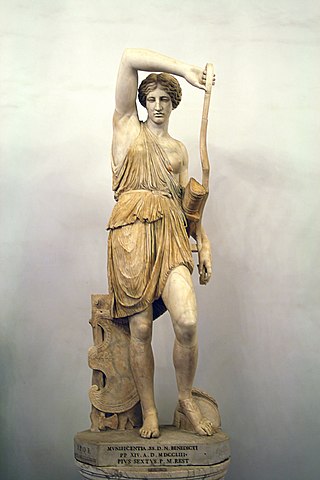
The Amazons were a people in Greek mythology, portrayed in a number of ancient epic poems and legends, such as the Labours of Heracles, the Argonautica and the Iliad. They were female warriors and hunters, known for their physical agility, strength, archery, riding skills, and the arts of combat. Their society was closed to men and they raised only their daughters and returned their sons to their fathers, with whom they would only socialize briefly in order to reproduce.

The Inca Empire, officially known as the Realm of the Four Parts, was the largest empire in pre-Columbian America. The administrative, political, and military center of the empire was in the city of Cusco. The Inca civilization rose from the Peruvian highlands sometime in the early 13th century. The Spanish began the conquest of the Inca Empire in 1532, and by 1572 the last Inca state was fully conquered.

During the Age of Discovery, a large scale colonization of the Americas, involving a number of European countries, took place primarily between the late 15th century and the early 19th century. The Norse explored and colonized areas of Europe and the North Atlantic, colonizing Greenland and creating a short-term settlement near the northern tip of Newfoundland circa 1000 AD. However, due to its long duration and importance, the later colonization by the European powers involving the continents of North America and South America is more well-known.

The Aztecs were a Mesoamerican civilization that flourished in central Mexico in the post-classic period from 1300 to 1521. The Aztec people included different ethnic groups of central Mexico, particularly those groups who spoke the Nahuatl language and who dominated large parts of Mesoamerica from the 14th to the 16th centuries. Aztec culture was organized into city-states (altepetl), some of which joined to form alliances, political confederations, or empires. The Aztec Empire was a confederation of three city-states established in 1427: Tenochtitlan, the capital city of the Mexica or Tenochca, Tetzcoco, and Tlacopan, previously part of the Tepanec empire, whose dominant power was Azcapotzalco. Although the term Aztecs is often narrowly restricted to the Mexica of Tenochtitlan, it is also broadly used to refer to Nahua polities or peoples of central Mexico in the prehispanic era, as well as the Spanish colonial era (1521–1821). The definitions of Aztec and Aztecs have long been the topic of scholarly discussion ever since German scientist Alexander von Humboldt established its common usage in the early 19th century.

The Scythians or Scyths in composition) and sometimes also referred to as the Pontic Scythians, were an ancient Eastern Iranic equestrian nomadic people who had migrated during the 9th to 8th centuries BC from Central Asia to the Pontic Steppe in modern-day Ukraine and Southern Russia, where they remained established from the 7th century BC until the 3rd century BC.
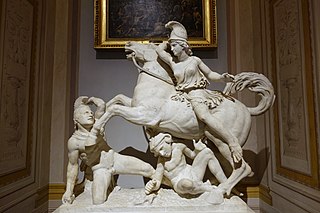
In Greek mythology, an Amazonomachy is a mythological battle between the ancient Greeks and the Amazons, a nation of all-female warriors. The subject of Amazonomachies was popular in ancient Greek art and Roman art.

A tribute is wealth, often in kind, that a party gives to another as a sign of submission, allegiance or respect. Various ancient states exacted tribute from the rulers of lands which the state conquered. In the case of alliances, lesser parties may pay tribute to more powerful parties as a sign of allegiance. Tributes are different from taxes, as they are not collected in the same regularly routine manner that taxes are. Further, with tributes, a recognition of political submission by the payer to the payee is uniquely required.
The Tupi people, a subdivision of the Tupi-Guarani linguistic families, were one of the largest groups of indigenous peoples in Brazil before its colonization. Scholars believe that while they first settled in the Amazon rainforest, from about 2,900 years ago the Tupi started to migrate southward and gradually occupied the Atlantic coast of Southeast Brazil.

Amazonas is a state of Brazil, located in the North Region in the north-western corner of the country. It is the largest Brazilian state by area and the ninth-largest country subdivision in the world with an area of 1,570,745.7 square kilometers. It is the largest country subdivision in South America, being greater than the areas of Chile, Paraguay, and Uruguay combined. Neighbouring states are Roraima, Pará, Mato Grosso, Rondônia, and Acre. It also borders the nations of Peru, Colombia and Venezuela. This includes the Departments of Amazonas, Vaupés and Guainía in Colombia, as well as the Amazonas state in Venezuela, and the Loreto Region in Peru.

Conquistadors or conquistadores is the term used to refer to Spanish and Portuguese soldiers and explorers who carried out the conquests and explorations of the Age of Discovery. Conquistadors sailed beyond the Iberian Peninsula to the Americas, Oceania, Africa and Asia, establishing new colonies and trade routes. They brought much of the "New World" under the dominion of Spain and Portugal.

El Dorado is a mythical city of gold supposedly located somewhere in South America. The king of this city was said to be so rich that he would cover himself from head to foot in gold dust – either daily or on certain ceremonial occasions – before diving into a sacred lake to wash it off. The legend was first recorded in the 16th century by Spanish colonists in America; they referred to the king as El Dorado, 'The Golden One', a name which eventually came to be applied to the city itself.

The Muisca are an Indigenous people and culture of the Altiplano Cundiboyacense, Colombia, that formed the Muisca Confederation before the Spanish conquest. The people speak Muysccubun, a language of the Chibchan language family, also called Muysca and Mosca. The first known contact with the West was dispatched by the Spanish Empire in 1537 at the time of the conquest.

The Dahomey Amazons were a Fon all-female military regiment of the Kingdom of Dahomey that existed from the 17th century until the late 19th century. They were the only female army in modern history. They were named Amazons by Western Europeans who encountered them, due to the story of the female warriors of Amazons in Greek mythology.
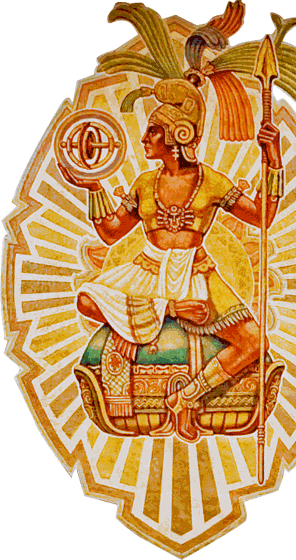
Calafia, or Califia, is the fictional queen of the island of California, first introduced by 16th century poet Garci Rodríguez de Montalvo in his epic novel of chivalry, Las sergas de Esplandián, written around 1510. She is the namesake of the California region encompassing the U.S. state of California and the Mexican states of Baja California and Baja California Sur.
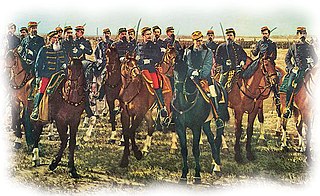
The Conquest of the Desert was an Argentine military campaign directed mainly by General Julio Argentino Roca during the 1870s and 1880s with the intention of establishing dominance over Patagonia, inhabited primarily by indigenous peoples. The Conquest of the Desert extended Argentine territories into Patagonia and ended Chilean expansion in the region.
The Araucanization of Patagonia was the process of the expansion of Mapuche culture, influence, and its Mapudungun language from Araucanía across the Andes into the plains of Patagonia. Historians disagree over the time period during which the expansion took place, but estimate it occurred roughly between 1550 and 1850.
The Berbers are an indigenous ethnic group of the Maghreb region of North Africa. Following the Muslim conquest of the Maghreb, most Berber tribes eventually became Muslims. Presently, about one-sixth of the population of Maghreb speaks one of the Berber languages, but most of them also speak some form of Arabic. Berbers are the first non-Arab people to have established an Islamic state.

The Conquest of Chile is a period in Chilean historiography that starts with the arrival of Pedro de Valdivia to Chile in 1541 and ends with the death of Martín García Óñez de Loyola in the Battle of Curalaba in 1598, and the subsequent destruction of the Seven Cities in 1598–1604 in the Araucanía region.
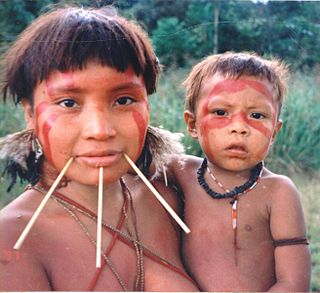
The Yanomami, also spelled Yąnomamö or Yanomama, are a group of approximately 35,000 indigenous people who live in some 200–250 villages in the Amazon rainforest on the border between Venezuela and Brazil.
References
- 1 2 Dictionary of Women Worldwide: 25,000 Women Through the Ages. Thomson Gale. 1 January 2007. Archived from the original on 19 April 2018.
- ↑ Women in World History: A Biographical Encyclopedia. 1 January 2002. Archived from the original on 19 April 2018. Retrieved 19 April 2018.
- 1 2 3 4 5 6 7 Leonard, Irving Albert (1949). Books of the Brave: Being an Account of Books and of Men in the Spanish Conquest and Settlement of the Sixteenth-century New World. University of California Press. p. 63. ISBN 9780520079908.
- ↑ Bradley, Peter T.; Cahill, David Patrick (2000). Habsburg Peru: Images, Imagination and Memory . Liverpool University Press. p. 18. ISBN 9780853239147.
- 1 2 3 4 Thomas, Hugh (2014). World Without End: The Global Empire of Philip II. Penguin Books Limited. p. 138. ISBN 9780241004845 . Retrieved 19 April 2018.
- ↑ Salmonson, Jessica Amanda (2015). The Encyclopedia of Amazons: Women Warriors from Antiquity to the Modern Era. Open Road Media. ISBN 9781453293645 . Retrieved 19 April 2018.